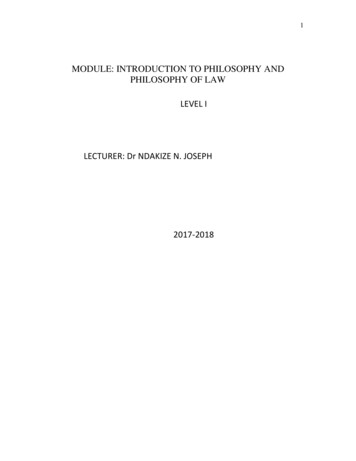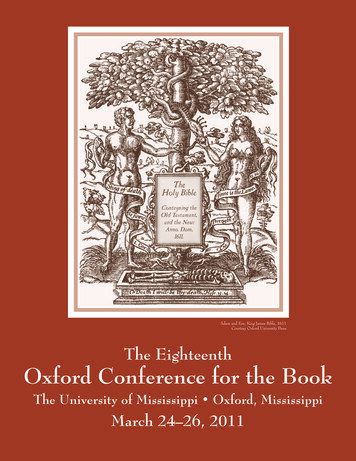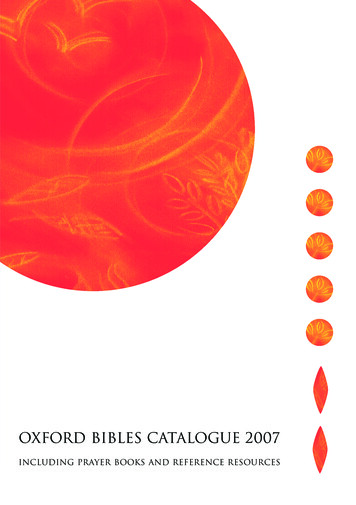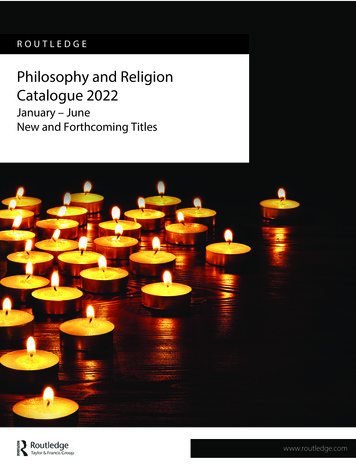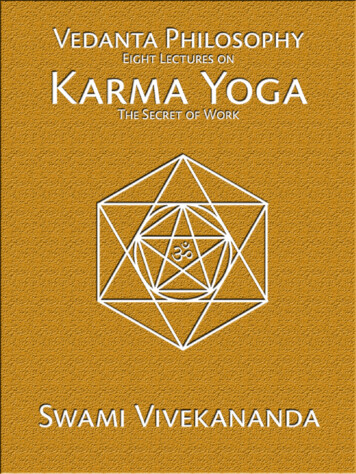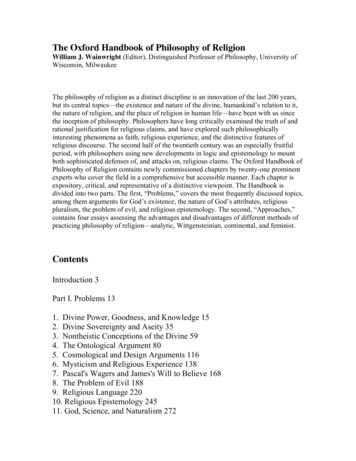
Transcription
The Oxford Handbook of Philosophy of ReligionWilliam J. Wainwright (Editor), Distinguished Professor of Philosophy, University ofWisconsin, MilwaukeeThe philosophy of religion as a distinct discipline is an innovation of the last 200 years,but its central topics—the existence and nature of the divine, humankind’s relation to it,the nature of religion, and the place of religion in human life—have been with us sincethe inception of philosophy. Philosophers have long critically examined the truth of andrational justification for religious claims, and have explored such philosophicallyinteresting phenomena as faith, religious experience, and the distinctive features ofreligious discourse. The second half of the twentieth century was an especially fruitfulperiod, with philosophers using new developments in logic and epistemology to mountboth sophisticated defenses of, and attacks on, religious claims. The Oxford Handbook ofPhilosophy of Religion contains newly commissioned chapters by twenty-one prominentexperts who cover the field in a comprehensive but accessible manner. Each chapter isexpository, critical, and representative of a distinctive viewpoint. The Handbook isdivided into two parts. The first, “Problems,” covers the most frequently discussed topics,among them arguments for God’s existence, the nature of God’s attributes, religiouspluralism, the problem of evil, and religious epistemology. The second, “Approaches,”contains four essays assessing the advantages and disadvantages of different methods ofpracticing philosophy of religion—analytic, Wittgensteinian, continental, and feminist.ContentsIntroduction 3Part I. Problems 131. Divine Power, Goodness, and Knowledge 152. Divine Sovereignty and Aseity 353. Nontheistic Conceptions of the Divine 594. The Ontological Argument 805. Cosmological and Design Arguments 1166. Mysticism and Religious Experience 1387. Pascal's Wagers and James's Will to Believe 1688. The Problem of Evil 1889. Religious Language 22010. Religious Epistemology 24511. God, Science, and Naturalism 272
12. Miracles 30413. Faith and Revelation 32314. Morality and Religion 34415. Death and the Afterlife 36616. Religious Diversity 392Part II. Approaches 41917. Analytic Philosophy of Religion 42118. Wittgensteinianism 44719. Continental Philosohy of Religion 47220. Feminism and Analytic Philosophy of Religion 494INTRODUCTIONWilliam J. WainwrightThe expression “philosophy of religion” did not come into general use until thenineteenth century, when it was employed to refer to the articulation and criticism ofhumanity's religious consciousness and its cultural expressions in thought, language,feeling, and practice. Historically, philosophical reflection on religious themes had twofoci: first, God or Brahman or Nirvana or whatever else the object of religious thought,attitudes, feelings, and practice was believed to be, and, second, the human religioussubject, that is, the thoughts, attitudes, feelings, and practices themselves. The first sort ofphilosophical reflection has had a long history. In the West, for example, discussions ofthe nature of God (whether he is unchanging, say, or knows the future, whether hisexistence can be rationally demonstrated, and the like) are incorporated in theologicaltreatises such as Anselm's Proslogion and Monologion, Thomas Aquinas's Summas,Maimonides' Guide for the Perplexed, and al-Ghazali's Incoherence of the Philosophers.They also form part of influential metaphysical systems like Plato's, Plotinus's,Descartes', and Leibniz's. Hindu Vedanta and classical Buddhism included sophisticateddiscussions of the nature of the Brahman and of the Buddha, respectively. Manycontemporary philosophers of religion continue to be engaged with these topics (see, forexample, chapters 1 through 5 and 8).The most salient feature of this sort of philosophy of religion is its attempts to establishtruths about God or the Absolute on the basis of unaided reason. Aquinas is instructive.Some truths about God can be known only with the help of revelation. Examples are histriune nature and incarnation. Other truths about him, such as his existence, simplicity,wisdom, and power, are included in hisend p.3
revelation to us but can also be known through reason. And Aquinas proceeds to showhow reason can establish them. What we would today call philosophy of religion (ornatural theology) is thus an integral part of his systematic theology. Early modernphilosophers like Descartes, Leibniz, and Locke are only incidentally concerned withpurely theological issues, but they too insist that some important truths about God can beestablished by purely philosophical reflection.The notion that we should accept only those religious beliefs that can be established byreason was not commonly expressed until the later part of the seventeenth century,however, and not widely embraced until adopted by the eighteenth-centuryEnlightenment. The consequences of the new commitment to reason alone depended onwhether important religious truths could be established by natural reason. Deists believedthat they could. Human reason can prove the existence of God and immortality anddiscover basic moral principles. Because these religious beliefs are the only ones that canbe established by unaided human reason, they alone are required of everyone. They arealso the only beliefs needed for religious worship and practice. Beliefs wholly or partlybased on some alleged revelation, on the other hand, are needless at best and perniciousat worst. Others, such as Hume, adopted a more skeptical attitude toward reason'spossibilities. In their view, reason is unable to show that “God exists” or that any otherimportant religious claim is significantly more probable than not. The only properattitude for a reasonable person to take, therefore, is disbelief (atheism) or unbelief(agnosticism). The result of this insistence on reason alone was thus that religion eitherbecame desiccated, reduced to a few simple beliefs distilled from the rich traditionalsystems that had given life to them, or ceased to be a live option.Reaction was inevitable, and took two forms. One was a shift from theoretical to practical(moral) reason. Kant, for example, was convinced that “theoretical” or “speculative”reason could neither prove nor disprove God's existence or the immortality of the soul.Practical reason, on the other hand, provided a firm basis for a religion lying within the“boundaries of reason alone.” The existence of God and an afterlife can't be establishedby theoretical reason. A belief in them, however, is a necessary presupposition ofmorality. Others, such as Friedrich Schleiermacher, shifted their attention fromintellectual belief and moral conduct to religious feelings and experience. In their view,the latter, and not the former, are the root of humanity's religious life. Both approacheswere widely influential in the nineteenth and early twentieth century. The first fell intoneglect with the waning of philosophical idealism in the first half of the twentiethcentury, although interest in it has recently resurfaced (see chapter 14). The second hascontinued to be attractive to many important philosophers of religion (see chapters 6 and10).Philosophy of religion was comparatively neglected by academic philosophers in the firsthalf of the twentieth century. There were several reasons for this. One was thewidespread conviction that the traditional “proofs” were bankrupt. Beend p.4
lievers and nonbelievers alike were persuaded that Hume and Kant had clearly exposedtheir fatal weaknesses. Another was the demise of nineteenth-century idealism. Thetwentieth-century heirs of the German and Anglo-American idealists (Hastings Rashdall,W. R. Sorley, A. C. Ewing, and A. E. Taylor, among others) had many interesting thingsto say about God, immortality, and humanity's religious life. But their views increasinglyfell on deaf ears as analytic philosophy replaced idealism as the dominant approachamong English-speaking academics. (The “process philosophy” of A. N. Whitehead andhis followers emerged as an alternative to idealism and analytic philosophy that couldaccommodate religious interests. It was never more than a minority viewpoint, however,and finds itself today in much the same position that philosophical idealism was in in theearly part of the twentieth century; its demise too seems immanent.) This is not to saythat nothing of interest to philosophers of religion was transpiring during this period.Five developments were especially important. The first was the impact of theologianslike Karl Barth, Emil Brunner, and Paul Tillich on philosophers interested in religion.The second was the influence of religious existentialism, including both the rediscoveryof Søren Kierkegaard and the work of contemporaries like Gabriel Marcel and MartinBuber. A third was the renewal of Thomism by Jacques Maritain, Etienne Gilson, andothers. A fourth was the rise of religious phenomenology; Rudolf Otto and others tried toaccurately describe human religious experience as it appears to those who have it.Finally, philosophers who were sympathetic to religious impulses and feelings yet deeplyskeptical of religious metaphysics attempted to reconstruct religion in a way that wouldpreserve what was thought to be valuable in it while discarding the chaff. Thus, JohnDewey suggested that the proper object of faith isn't supernatural beings but “the unity ofall ideal ends arousing us to desire and actions,” or the “active relation” between theseideals and the “forces in nature and society that generate and support” them. In Dewey'sview, “any activity pursued in behalf of an ideal end against obstacles and in spite ofthreats of personal loss because of a conviction of its general and enduring value isreligious in quality”1 (see chapter 9).After a half century of comparative neglect, analytic philosophers began to take aninterest in religion in the 1950s. Their attention was initially focused on questions ofreligious language. Were sentences like “God forgives my sins” used to express factualclaims, or did they instead express the speaker's attitudes or commitments? If those whouttered them did express factual claims, what kind of claims were they? Could they beempirically verified or falsified, for example, and, if they could not, were they reallycognitively meaningful? (For more on this debate, see chapters 9, 10, 18, and 19.)What was unanticipated was that the young analytic philosophers of religion who werebeing trained during this period were to become responsible for a resurgence ofphilosophical theology that began in the mid-1960s and continues to dominate the field inEnglish-speaking countries today. The revival was fueled by a comparative loss ofinterest in the question of religious language's cognitive meaningfulness (it beinggenerally thought that attempts to show that religious sentences do not express true orfalse factual claims had been unsuccessful), and a conviction that Hume's and Kant'sallegedly devastating criticisms of philosophical theology did not withstand carefulscrutiny. On the positive side, developments in modal logic, probability theory, and so onoffered tools for introducing a new clarity and rigor to traditional disputes.
Three features of the revival are especially noteworthy. The first was a renewed interestin the scholastics and in seventeenth- and eighteenth-century philosophical theology.There were at least two reasons for this. One was the discovery that issues central to thedebates of the 1960s and 1970s had already been examined with a sophistication anddepth lacking in most nineteenth- and early twentieth-century discussions of the sameproblems. The other was the fact that a significant number of analytic philosophers ofreligion were practicing Christian or Jewish theists. Figures such as Aquinas, Scotus,Maimonides, Samuel Clark, and Jonathan Edwards were attractive models for thesephilosophers for two reasons. There is a broad similarity between the philosophicalapproaches of these medieval and early modern thinkers and contemporary analyticphilosophers: precise definitions, careful distinctions, and rigorous argumentation arefeatures of both. In addition, these predecessors were self-consciously Jewish orChristian; a conviction of the truth or splendor of Judaism or Christianity pervades theirwork. They were thus appealing models for contemporary philosophers of religion withsimilar commitments.A second feature of contemporary analytic philosophy of religion is the wide array oftopics it addresses. The first fifteen years or so of the period in question were dominatedby discussions of issues traditionally central to the philosophy of religion: Is the conceptof God coherent? Are there good reasons for thinking that God exists? Is the existence ofevil a decisive reason for denying God's existence? However, beginning in the 1980s, anumber of Christian analytic philosophers turned their attention to such specificallyChristian doctrines as the Trinity, the Incarnation, and the Atonement. Most of thearticles and books on these topics were attempts to show that the doctrines in questionwere coherent or rational. But some were more interested in the bearing of theologicaldoctrines on problems internal to the traditions that include them. Marilyn Adams, forexample, has argued that Christian martyrdom and Christ's passion have importantimplications for Christian responses to the problem of evil, and Robert Oakes has madesimilar claims for the Jewish mystical doctrine of God's withdrawal (tzimzum). Still otheranalytic philosophers of religion have tried to show that theism can cast light on problemsin other areas of philosophy—that it can give a better account of the logical features ofnatural laws, for example, or of the nature ofend p.6numbers, sets, and other mathematical objects, or of the apparent objectivity of moralclaims.2 (On the last, see chapter 14.)A third characteristic of recent philosophy of religion is its turn toward epistemology.Medieval and seventeenth-century philosophical theology exhibited a feature that hasbeen insufficiently appreciated since the eighteenth century and is especially prominentin Augustine and Anselm: its devotional setting. Anselm's inquiry, for instance, ispunctuated by prayers to arouse his emotions and stir his will. His inquiry is a divinehuman collaboration in which he continually prays for assistance and offers praise andthanksgiving for the light he has received. His project as a whole is framed by a desire to“contemplate God” or “see God's face.” Anselm's attempt to understand what he believesby finding reasons for it is largely a means to this end.3 Several hundred years later,
Blaise Pascal argued that although the evidence for the truth of the Christian religion isambiguous, it is sufficient to convince those who seek God or “have the living faith intheir hearts.” Reflection on the work of predecessors like these suggests two things. Thefirst is that the aim of philosophical theology is not, primarily, to convince nonbelieversof the truth of religious claims but, rather, self-understanding: to enable the believer tograsp the implications of, and reasons for, his or her religious beliefs. The project, inother words, is faith in search of understanding. The second is that a person's attitudes,feelings, emotions, and aims have an important bearing on his or her ability to discernreligious truths. C. Stephen Evans, for example, has suggested that faith may be anecessary condition of appreciating certain reasons for religious belief. I have argued thata properly disposed heart may be needed to grasp the force of evidence for theisticbelief.4 Common to much recent religious epistemology is a rejection of any form ofevidentialism that insists that religious beliefs are reasonably held only if they aresupported by evidence that would convince any fair-minded, properly informed, andintelligent person regardless of the state of his or her heart (see chapters 10 and 13).As its history indicates, the aims of philosophers of religion can be quite diverse.Arguments are sometimes employed apologetically. For example, Samuel Clarke andWilliam Paley attempted to construct proofs that would convince any fair-minded andintelligent reader of God's existence and providential government of human affairs. Theseproofs had begun to lose their power to persuade educated audiences by the end of theeighteenth century, however, and so Friedrich Schleiermacher and others turned toreligious feelings (a sense of absolute dependence or of the unity of all things in theinfinite) to justify religion to its “cultured despisers.” But although Schleiermacherthought that the heart and not the head is religion's primary source, the aim of hisargument was still apologetic.Yet philosophy of religion can have other purposes. Theistic proofs, for example, havebeen used to persuade nonbelievers of the truth of theism. But, as we have seen, they canalso be used devotionally, and this is sometimes theirend p.7primary purpose. Thus, Udayana's Nyayakusumanjali (which can be roughly translated as“A bouquet of arguments offered to God”) has three purposes: to convince unbelievers, tostrengthen the faithful, but also to please Siva “by presenting it as an offering at hisfootstool.” Regardless of the success Udayana's arguments may or may not have had inachieving his first two goals, they have value as a gift offered to God; their constructionand presentation is an act of worship.5Philosophy of religion is sometimes part of a larger philosophical project. For example,for Hegel, religion is the self-representation of Absolute Spirit in feeling and images. Assuch, it is a stage in a historical process that culminates in philosophy (i.e., in Hegel'sphilosophy!). Descartes provides another example. His Meditations introduce ontologicalarguments for God's existence to help resolve skeptical doubts raised earlier in the text(see chapter 4).Philosophy of religion can also be part of the so-called Enlightenment project. Religiousbeliefs, institutions, and practices are critically examined in an attempt to eliminate thosethat can't survive the scrutiny of impartial reason. Hume's Dialogues and The Natural
History of Religion and Kant's reflections on religion and morality are examples. The“hermeneutics of suspicion” practiced by Marx, Nietzsche, and Freud is an extension ofthe same project. According to these thinkers, religion is an expression of “falseconsciousness.” Its beliefs, feelings, and practices lack rational support and rest onmotives that cannot be consciously acknowledged without destroying their credibility(see chapter 19).Finally, philosophy of religion can be an attempt to make sense of, or account for,religion, and not a reflection on its object (God, Nirvana, and the like). GeorgeSantayana's interpretation of religion as a kind of poetry, a feelingful contemplation ofideal forms, is an example; Hume's Natural History of Religion is another. As theseexamples indicate, attempts of this sort are seldom neutral. Santayana, for instance, takesnaturalism for granted, and Hume is independently convinced that historical religions arenot only irrational but morally and socially pernicious. Wittgensteinians, on the otherhand, insist that their attempts to make sense of religion are an exception to this rule;their project, they claim, is to simply understand religion, not judge it (see chapter 18).Until quite recently, philosophy of religion has been somewhat myopic. Since the onlyreligions with which Western philosophers have been intimately acquainted are Judaismand Christianity (and, to a lesser extent, Islam), it is not surprising that they have focusedtheir attention on theism. (Discussions of mysticism have proved one noteworthyexception.) Increased knowledge of Asian and other traditions has made this attitudeseem unduly parochial. There is no intrinsic reason, however, why the tools of analytic orcontinental philosophy can't be profitably applied to non-Western doctrines andarguments, and good work is currently being done in this vein by Stephen Phillips, PaulWilliams, Steven Collins, Gerald Larson, and a number of others. Paul Griffiths, forexample, hasend p.8suggested that “perfect being theology” (the attempt to explore the implications of theconcept of a reality greater than which none can be thought) can be deployed to explain(and criticize) the emergence of doctrines of the cosmic Buddha in the Mahayanatraditions. Work of this sort is essential because a defense of one's favored religion'sperspective should include reasons for preferring it to its important competitors. TheWestern doctrine of creation ex nihilo, for instance, should be compared with theVisistadvaitin notion that the world is best viewed as God's body.6 Again, because theBuddhist's claim that everything is impermanent is logically incompatible with theassertion that God is eternal and unchanging, both theists and Buddhists need to attend tothe views of each other. (For more on these issues, see chapters 3 and 16.)Another weakness of contemporary philosophy of religion is that the analytic andcontinental traditions have developed in comparative isolation from each other. This isdue to several factors. For one thing, analytic philosophers of religion are usually trainedand housed in departments of philosophy, and most of the best departments in Englishspeaking countries are dominated by analytic philosophy. Continental philosophers ofreligion, on the other hand, are often (although not always) trained and housed indepartments of religion or theology. Their interests, too, are different. Analyticphilosophers of religion have tended to focus on God or the religious object and on the
rational credentials of claims about it. Continental philosophy of religion has tended tofocus on religion and the human subject; it has also been more concerned with religion'sethical implications, especially its bearing on oppression and liberation.The isolation of the two traditions is unfortunate because each needs what the other has tooffer. Analytic philosophers of religion, for instance, need to take the hermeneutics ofsuspicion seriously, for, as Merold Westphal has said, they have been largely blind “tothe cognitive implications of finitude and sin.”7 As a result, they have usually ignored theideological uses and abuses of theistic metaphysics and the ethical issues this raises. Thecritiques of Marx, Nietzsche, Freud, Jacques Derrida, and contemporary feminists canand should alert analytic philosophers of religion to these perils (see chapters 19 and 20).Continental philosophers of religion, on the other hand, too often ignore questions oftruth and rational adequacy. This is unfortunate for two closely related reasons. The firstis ethical: we fail to respect the men and women whose beliefs and practices we examineif we don't treat their claims to truth and rational superiority with the same seriousnessthat they do. The second is this: if Christianity, say, or Buddhism is true, it mattersinfinitely. So if either is a live possibility, a deeply serious concern with its truth orfalsity, its reasonableness or unreasonableness, is the only rational option. Inattention orindifference to the truth and rational credentials of the traditions one examines is a clearindication that one doesn't take them as live possibilities, and hence doesn't invest themwith the same importance or seriousness that their adherents do.end p.9There are some indications that analytic and continental philosophers of religion arebeginning to learn from each other. One can only hope that this trend increases in thefuture.The Oxford Handbook of Philosophy of Religion is divided into two parts. Part 1 coversthe most frequently discussed problems in the field. Part 2 consists of essays assessingthe advantages and disadvantages of the four currently most influential ways of doingphilosophy of religion; each is by a well-known practitioner of the way he or shediscusses. The essays in Part 2 are a unique feature of this volume and are important fortwo reasons. First, one's philosophical approach affects one's selection of problems andthe way one frames them, and this, in turn, affects one's results. For example, followersof Emmanuel Levinas or feminist philosophers of religion have different takes on theproblem of evil than do analytic philosophers. No picture of the philosophy of religionthat ignores them can be complete. Second, although the analytic approach dominates thepractice of philosophy of religion in English-speaking countries and is beginning to makesignificant inroads on the continent, there are other historically important and potentiallyilluminating ways of doing philosophy of religion. It is therefore important that a generalreference work of this sort acquaint the reader with the variety of approaches to thediscipline.The twenty chapters of this volume are written by prominent experts in the field. Eachchapter is expository, critical, and representative of a distinctive viewpoint. In beingexpository, the chapters formulate and elucidate important competing positions on theirtopic (e.g., religious experience or the problem of evil) or the history and nature of thephilosophical approach to the philosophy of religion that they are discussing (the
analytic, say, or feminist). In being critical, the chapters carefully assess the viewspresented on their topics or the strengths and alleged weakness of their approach to thephilosophy of religion. Readers will thus see not only what the prominent views andapproaches in philosophy of religion are but encounter noteworthy criticisms of them aswell. In being representative of a distinctive viewpoint the chapters present their authors'own views on the topic or approach. Readers will thereby encounter not only expositionand criticism but the substantial development of a viewpoint on the subject underdiscussion by a well-known author in the discipline. Finally, in addition to exposition,criticism, and original philosophical development, each chapter includes topicalbibliographies identifying key works in the field. It is our hope that the Handbook'scombination of topical and methodological comprehensiveness, criticism, and originalphilosophical development will provide the reader with a unique and invaluable referencework on the philosophy of religion.NOTES1.John Dewey, A Common Faith (New Haven: Yale University Press, 1934), 42, 50–51,27.2.See Marilyn McCord Adams, Horrendous Evils and the Goodness of God (Ithaca,N.Y.: Cornell University Press, 1999), and Robert Oakes, “Creation as Theodicy: ADefense of a Kabbalistic Approach to Evil,” Faith and Philosophy 14 (1997): 510–21.For attempts to offer theistic accounts of natural laws, mathematical objects, and moralclaims see, e.g., Del Ratzsch, “Nomo(theo)logical Necessity,” and Christopher Menzel,“Theism, Platonism, and the Metaphysics of Mathematics,” both in Christian Theism andthe Problems of Philosophy, ed. Michael D. Beaty (Notre Dame, Ind.: University ofNotre Dame Press, 1990), 184–207 and 208–29, respectively; Philip L. Quinn, DivineCommands and Moral Requirements (Oxford: Clarendon Press, 1978); and Robert M.Adams, Finite and Infinite Goods (New York: Oxford University Press, 1999).3.See Marilyn McCord Adams, “Praying the Proslogion: Anselm's Theological Method,”in The Rationality of Belief and the Plurality of Faith, ed. Thomas D. Senor (Ithaca,N.Y.: Cornell University Press, 1995), 13–39.4.See C. Stephen Evans, Passionate Reason: Making Sense of Kierkegaard'sPhilosophical Fragments (Bloomington: Indiana University Press, 1992), and William J.Wainwright, Reason and the Heart (Ithaca, N.Y.: Cornell University Press, 1995).5.John Clayton, “Piety and the Proofs,” Religious Studies 26 (1990): 19–42.6.It should be noted, however, that, on the Visistadvaitin view, bodies are absolutelydependent on souls although souls are not dependent on bodies. So the differencesbetween the two views should not be exaggerated. See William J. Wainwright,Philosophy of Religion, 2d edition (Belmont, Calif.: Wadsworth, 1998), 192–96.7.Merold Westphal, “Traditional Theism, the AAR and the APA,” in God, Philosophy,and Academic Culture, ed. William J. Wainwright (Atlanta: Scholars Press, 1996), 21–27.end p.11
end p.12PART I PROBLEMSend p.13end p.141 DIVINE POWER, GOODNESS, AND KNOWLEDGEWilliam L. RoweIn the major religions of the West—Judaism, Christianity, and Islam—the dominanttheological tradition has long held that among the attributes constituting the nature ofGod are to be counted his unlimited power (omnipotence), perfect goodness, andunlimited knowledge (omniscience). Within this theological tradition stands the work ofmany influential theologians and philosophers such as Maimonides (1135–1204),Aquinas (1225–1274), and al-Ghazali (1059–1111), who have labored to explain how weshould understand these fundamental aspects of the divine nature. Our aim here is both toexplain these three attributes of the divine nature and to discuss some of the difficultiesphilosophers and theologians have suggested arise when we endeavor to conceive of abeing possessing such extraordinary attributes. Before beginning this task, however, weshould note that the attributes ascribed to God in the historically dominant theologicaltradition within the major Western religions—including unlimited power (omnipotence),perfect goodness, and unlimited knowledge (omniscience)—are not characteristic of theentire history of thought about God in these religious traditions. Indeed, in the earlyreligious texts that are authoritative in these traditions one can find descriptions of thedivine being that do not suggest, let alone imply, that God is omnipotent, perfectly good,and omniscient. In the Old Testament of the Chris tian Bible, to cite just one exa
The Oxford Handbook of Philosophy of Religion . William J. Wainwright (Editor), Distinguished Professor of Philosophy, University of Wisconsin, Milwaukee . The philosophy of religion as a distinct discipline is an innovation of the last 200 years, but its central topics—the existe


